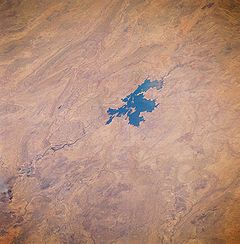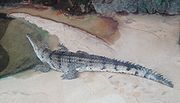
Lakes Argyle and Kununurra Ramsar Site
Encyclopedia

Freshwater
Fresh water is naturally occurring water on the Earth's surface in ice sheets, ice caps, glaciers, bogs, ponds, lakes, rivers and streams, and underground as groundwater in aquifers and underground streams. Fresh water is generally characterized by having low concentrations of dissolved salts and...
reservoir
Reservoir
A reservoir , artificial lake or dam is used to store water.Reservoirs may be created in river valleys by the construction of a dam or may be built by excavation in the ground or by conventional construction techniques such as brickwork or cast concrete.The term reservoir may also be used to...
s, with their associated permanent wetland
Wetland
A wetland is an area of land whose soil is saturated with water either permanently or seasonally. Wetlands are categorised by their characteristic vegetation, which is adapted to these unique soil conditions....
s, formed by damming
Dam
A dam is a barrier that impounds water or underground streams. Dams generally serve the primary purpose of retaining water, while other structures such as floodgates or levees are used to manage or prevent water flow into specific land regions. Hydropower and pumped-storage hydroelectricity are...
the Ord River
Ord River
The Ord River is a 320-kilometre-long river in the Kimberley region of Western Australia. It was named in honour of Harry Ord, Governor of Western Australia from 1877 to 1880....
in the eastern part of the Kimberley Region of northern Western Australia
Western Australia
Western Australia is a state of Australia, occupying the entire western third of the Australian continent. It is bounded by the Indian Ocean to the north and west, the Great Australian Bight and Indian Ocean to the south, the Northern Territory to the north-east and South Australia to the south-east...
. The reservoirs include Lake Argyle
Lake Argyle
Lake Argyle is Australia's second largest artificial lake by volume. It is part of the Ord River Irrigation Scheme and is located near the East Kimberley town of Kununurra...
and Lake Kununurra
Lake Kununurra
Lake Kununurra is a long linear lake in the Ord River valley formed in 1963 by the construction of the Ord Diversion Dam in Kununurra, northern Western Australia, which was built to supply water to the Ord River Irrigation Area. The lake stretches for upstream from the Diversion Dam at towards...
. There are numerous endemic plants and a rich fauna. The 1500 km² (579.2 sq mi) site was designated a wetland of international importance under the Ramsar Convention
Ramsar Convention
The Ramsar Convention is an international treaty for the conservation and sustainable utilization of wetlands, i.e., to stem the progressive encroachment on and loss of wetlands now and in the future, recognizing the fundamental ecological functions of wetlands and their economic, cultural,...
on 7 June 1990, making it Ramsar Site 478.
Description



The diversion dam
Diversion dam
A diversion dam is the term for a dam that diverts all or a portion of the flow of a river from its natural course. Diversion dams do not generally impound water in a reservoir...
on the Ord River was completed in 1963 as the first stage of the Ord River Irrigation Scheme. It flooded the Ord valley upstream towards the site of the Argyle Dam, creating Lake Kununurra and subsidiary wetlands such as Lily Creek Lagoon and the Packsaddle Swamps. The Argyle Dam was completed in 1972 as the second stage of the scheme, creating Lake Argyle. The town of Kununurra
Kununurra, Western Australia
Kununurra is a town in far northern Western Australia located at the eastern extremity of the Kimberley Region approximately from the border with the Northern Territory. Kununurra was initiated to service the Ord River Irrigation scheme....
was built at the site of the diversion dam, adjoining Lake Kununurra and Lily Creek Lagoon. Human use of the area includes irrigated
Irrigation
Irrigation may be defined as the science of artificial application of water to the land or soil. It is used to assist in the growing of agricultural crops, maintenance of landscapes, and revegetation of disturbed soils in dry areas and during periods of inadequate rainfall...
tropical agriculture
Tropical agriculture
Worldwide more human beings gain their livelihood from agriculture than any other endeavor; the majority are self-employed subsistence farmers living in the tropics...
, diamond mining and exploration
Argyle diamond mine
The Argyle Diamond Mine is a diamond mine located in the East Kimberley region in the remote north of Western Australia. Argyle is the largest diamond producer in the world by volume, although due to the low proportion of gem-quality diamonds, is not the leader by value. It is the only known...
, and with tourism
Tourism
Tourism is travel for recreational, leisure or business purposes. The World Tourism Organization defines tourists as people "traveling to and staying in places outside their usual environment for not more than one consecutive year for leisure, business and other purposes".Tourism has become a...
becoming increasingly important.
Flora and fauna
Water levels in Lake Argyle fluctuate annually by about 3 metres (9.8 ft) but those in Lake Kununurra and its associated wetlands are kept constant except for short periods when levels are lowered to control weed growth. There are dead trees throughout the wetland system which were killed by permanent flooding following dam construction. The lakes are deep and there are large areas of open water without aquatic plants. The large fluctuation in water levels in Lake Argyle has prevented vegetation establishment along most of the shoreline. However, because water levels are stable in Lake Kununurra and its associated wetlands, they have developed densely vegetated margins, with aquatic plants fringed by bulrushTypha
Typha is a genus of about eleven species of monocotyledonous flowering plants in the family Typhaceae. The genus has a largely Northern Hemisphere distribution, but is essentially cosmopolitan, being found in a variety of wetland habitats...
es, grassland
Grassland
Grasslands are areas where the vegetation is dominated by grasses and other herbaceous plants . However, sedge and rush families can also be found. Grasslands occur naturally on all continents except Antarctica...
and savanna
Savanna
A savanna, or savannah, is a grassland ecosystem characterized by the trees being sufficiently small or widely spaced so that the canopy does not close. The open canopy allows sufficient light to reach the ground to support an unbroken herbaceous layer consisting primarily of C4 grasses.Some...
woodland
Woodland
Ecologically, a woodland is a low-density forest forming open habitats with plenty of sunlight and limited shade. Woodlands may support an understory of shrubs and herbaceous plants including grasses. Woodland may form a transition to shrubland under drier conditions or during early stages of...
. Tree species found on the wetland margins include Broad-leaved Paperbark
Melaleuca viridiflora
Melaleuca viridiflora, known as broad-leaved paperbark, is a small tree native to woodlands, swamps and streams of monsoonal northern Australia and Papua New Guinea....
, Eucalyptus microtheca
Eucalyptus microtheca
Eucalyptus microtheca, commonly known as the coolibah, is a species of eucalypt native to Australia....
, River Red Gum, Nauclea orientalis
Nauclea orientalis
Nauclea orientalis is a species of tree in the Rubiaceae family. It is commonly known as the Leichhardt tree and yellow cheesewood, among other names. It grows to a maximum of around in height and has large glossy leaves. It bears spherical clusters of fragrant flowers that develop into golf...
, Sesbania formosa and Lophostemon grandiflorus.
The lakes form an important dry season
Dry season
The dry season is a term commonly used when describing the weather in the tropics. The weather in the tropics is dominated by the tropical rain belt, which oscillates from the northern to the southern tropics over the course of the year...
refuge for waterbirds, with regular numbers of over 20,000, and sometimes of up to 200,000, individuals. Lake Argyle contains some of the largest aggregations of waterbirds in northern Australia. Abundant species include Glossy Ibis
Glossy Ibis
The Glossy Ibis is a wading bird in the ibis family Threskiornithidae.This is the most widespread ibis species, breeding in scattered sites in warm regions of Europe, Asia, Africa, Australia, and the Atlantic and Caribbean region of the Americas...
(with up to 6,000 counted), Magpie Goose (10,500), Wandering Whistling Duck
Wandering Whistling Duck
The Wandering Whistling Duck is a species of whistling duck. They inhabit tropical and subtropical Australia, the Philippines, Indonesia, Papua New Guinea and the Pacific Islands . There are three subspecies associated with this bird. D. arcuata arcuata , D. arcuata australis , and D...
(11,000), Plumed Whistling Duck
Plumed Whistling Duck
The Plumed Whistling Duck , also called the Grass Whistle Duck , is a whistling duck which breeds in New Guinea and Australia. It is a predominantly brown-coloured duck with a long neck and characteristic plumes arising from its flanks...
(4,300), Radjah Shelduck
Radjah Shelduck
The Raja Shelduck or Radjah Shelduck , also known as the Burdekin Duck in Australia, is a species of shelduck. Placed in the genus Tadorna, it differs markedly in external morphology, and mtDNA cytochrome b sequence data suggests its status should be reinvestigated...
(900), Pacific Black Duck
Pacific Black Duck
The Pacific Black Duck is a dabbling duck found in much of Indonesia, New Guinea, Australia, New Zealand, and many islands in the southwestern Pacific, reaching to the Caroline Islands in the north and French Polynesia in the east. It is usually called the Grey Duck in New Zealand...
(16,000), Grey Teal
Grey Teal
The Grey Teal, Anas gracilis is a dabbling duck found in open wetlands in New Guinea, Australia, New Zealand, Vanuatu and Solomon Islands....
(17,200), Pink-eared Duck
Pink-eared Duck
The Pink-eared Duck is a species of duck found in Australia.It has a large spatulate bill like the Australasian Shoveler, but is smaller at 38–40 cm length. Its brown back and crown, black and white barred sides and black eye patches on its otherwise white face make this bird unmistakable...
(1,800), Hardhead
Hardhead
The Hardhead, Aythya australis, is the only true diving duck found in Australia. Hardheads are common in the south-east of Australia, particularly in the Murray-Darling Basin, but also in the wetter country near the coasts. They are moderately nomadic in normal years, but disperse widely in times...
(51,400), Green Pygmy Goose
Green Pygmy Goose
The Green Pygmy Goose is a small perching duck which breeds in southern New Guinea and northern Australia.First described in 1842 by the ornithologist John Gould, its specific name is derived from diminutive of the Latin adjective pulcher "pretty". It is one of three species in the Afro-Asian...
(1,500) and Eurasian Coot
Eurasian Coot
The Eurasian Coot, Fulica atra, also known as Coot, is a member of the rail and crake bird family, the Rallidae. The Australian subspecies is known as the Australian Coot.-Distribution:...
(50,000). The two lakes are a stronghold of the Comb-crested Jacana
Comb-crested Jacana
The Comb-crested Jacana , also known as the Lotusbird or Lilytrotter, is the only species of jacana in the genus Irediparra...
. Over 200 terrestrial and aquatic bird species have been recorded in the area, which also supports several kinds of microbat
Microbat
The microbats constitute the suborder Microchiroptera within the order Chiroptera . They are most often referred to by their scientific name...
s, the Little Red
Little Red Flying-fox
The Little Red Flying Fox is a species of megabat native to northern and eastern Australia. With a weight of it is large fruit bat, but the smallest Flying Fox in mainland Australia . It has the widest range of all the species, going much further inland than the larger fruit bats...
and Black Flying-fox
Black Flying-fox
The Black Flying-Fox, Pteropus alecto, is a megabat in the family Pteropodidae. Members of the genus Pteropus include the largest bats in the world. The Pteropus genus has currently about 57 recognised species...
es, Rakali, and large numbers of Freshwater Crocodiles.

